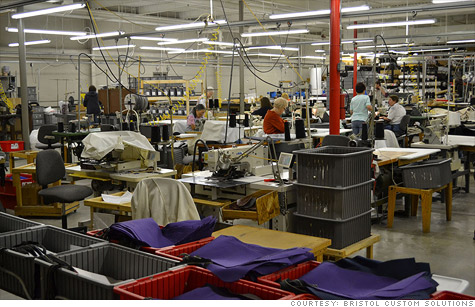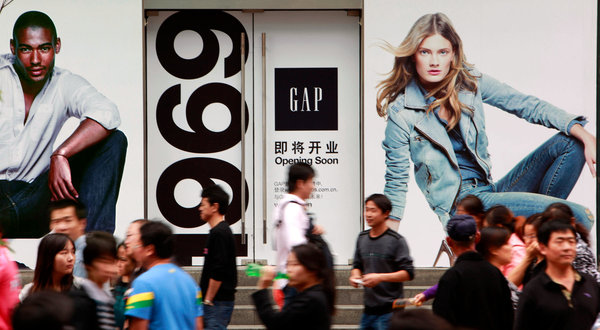
By Parija Kavilanz @CNNMoney February 13, 2012: 11:51 AM ET
NEW YORK (CNNMoney) — U.S. small businesses that initially rushed to Chinese factories to get their products made are now dumping them for American manufacturers.
And the shift is gaining traction, said industry experts who match U.S. small companies with domestic firms.
Mitch Free, the founder and CEO of Atlanta-based MFG.com, said his company has seen a 15% uptick in inquiries since 2009 from U.S. firms looking for American factories to replace their Chinese suppliers.
MFG.com is one of the largest online directories used by businesses to find domestic manufacturers.
One reason behind the trend is that “Chinese manufacturing has become expensive,” Free explained.
Another is that the U.S. economy is still uncertain. Most small businesses are forced to order large quantities to justify costs when dealing with companies overseas, he said. And that’s a risky move if American consumers are not splurging yet.
Manufacturers closer to home allow small businesses to order smaller batches, which means less of their money is tied up if their inventory is unsold, he said.
Revive Made in USA? Easier said than done

WindStream Technologies knows well the value of manufacturing in the United States.
In December 2010, the startup selected a Chinese factory to make 35 prototypes of its wind turbines, because they wanted them “quickly and cheaply,” said David Dingman, Windstream’s lead mechanical engineer.
It was a disaster. “The prototypes that the Chinese manufacturer sent back to us were junk,” said Dingman. “There were parts that were put upside down. Other parts were poor quality. Some even fell off.”
WindStream decided not to have the final products made in China.
The company was able to snag U.S. manufacturers with the help of MFG.com.
And last month, it started mass producing its small wind turbines for home use at its new 45,000-square-foot manufacturing facility in North Vernon, Ind. The company employs 30 workers and is hoping to ramp up to 100, if it lands a deal to sell the turbines at a mass retailer, said Dingman.
WindStream now has its turbine covers made in Chicago, while some metal parts are produced in Ohio.
Some of the turbines parts are still made in China, simply because the raw materials to make them don’t exist in the United States, said Dingham. But “the Midwest proved to be terrific for us,” he said.
Indeed. WindStream produces its turbines at a 10% lower cost per unit compared to what the company would have paid in China, thanks to its American suppliers that provide competitive prices and the elimination of overseas shipping and travel costs.
Del Mar, Calif., entrepreneur and inventor Julie Zizka actually liked the way her tote bags looked after a Chinese manufacturer produced 5,000 of them for her in 2008.
But she still was not a fan of having her manufacturing done overseas. She had concerns about production delays and fretted about how the extensive amount of transportation used was hurting the environment. What’s more, she noticed that her customers were preferring products that were made in the United States.
By 2011, she was looking for a U.S. manufacturer to produce her “Tote Buddy,” a colorful tote for storing reusable plastic bags.
She came across one after searching online and seeing ads for Bristol Custom Solutions, which heavily advertises on MacRAE’s Blue Book.
MacRAE’s has seen a pickup in inquiries — just like Zizka’s — from companies wanting to replace Chinese suppliers with American ones, said Lori Meloche, MacRAE’s vice president of marketing.
The directory — first published in the United States in 1893 as a “blue-colored book” — has since evolved into a website with more than 1.2 million North American industrial manufacturers, which averages 1.5 million users monthly.
What small firms want from Obama’s manufacturing plan
Zizka connected with Bristol, a 26-year-old, Tennessee-based manufacturer, best-known for making secure locking bags used by banks and the federal government to transport cash and other valuables.
“People have been contacting us all the time lately, telling us they don’t want to produce their products in China,” said Brandon Cantrell, Bristol’s general manager.
When Zizka sent Bristol a sample of the tote, the company redesigned it and brought down some of her costs, said Cantrell.
Today, Bristol is making 1,000 new Tote Buddy bags for sale this spring. For Zizka, the unit price for one of her Tote Buddy bags made in Cantrell’s factory is still 170% higher than for one made in the Chinese factory, said Cantrell.
But that doesn’t bother Zizka.
“My customers want my bag made in the U.S.,” she said, “I’m willing to absorb that cost if I can control the quality, get them to my customers faster and help the environment as well.”

You must be logged in to post a comment.